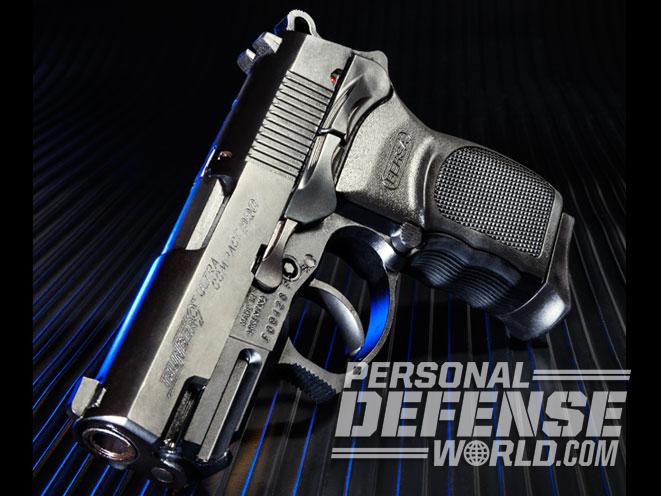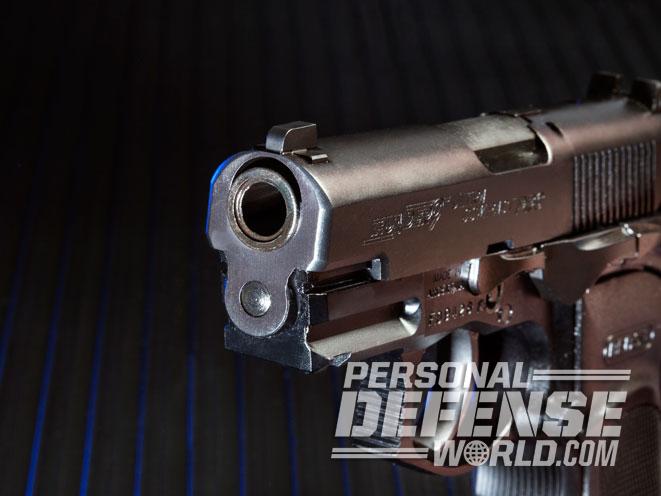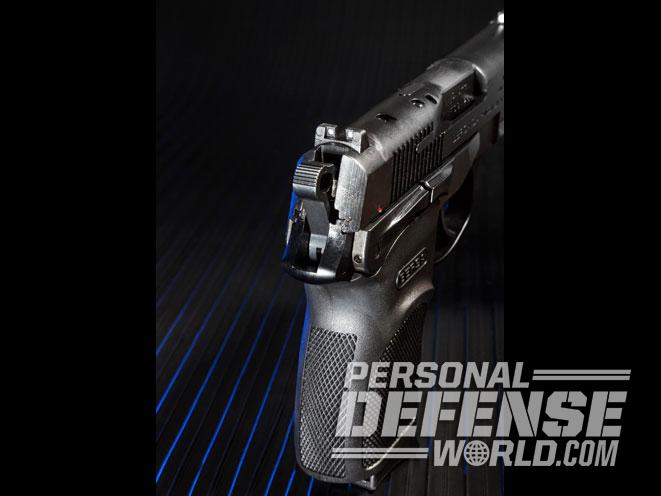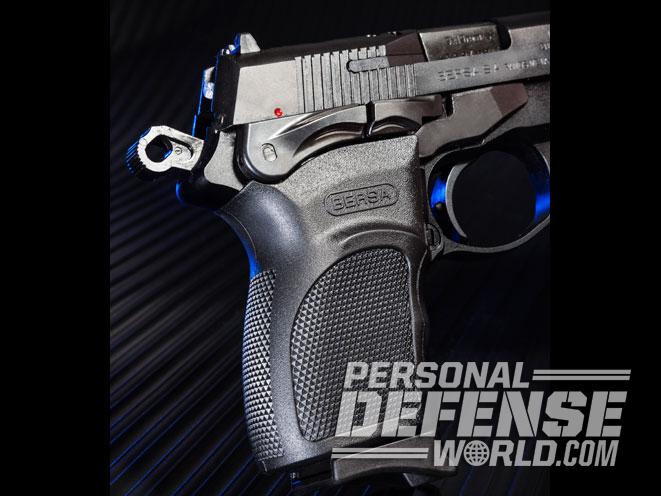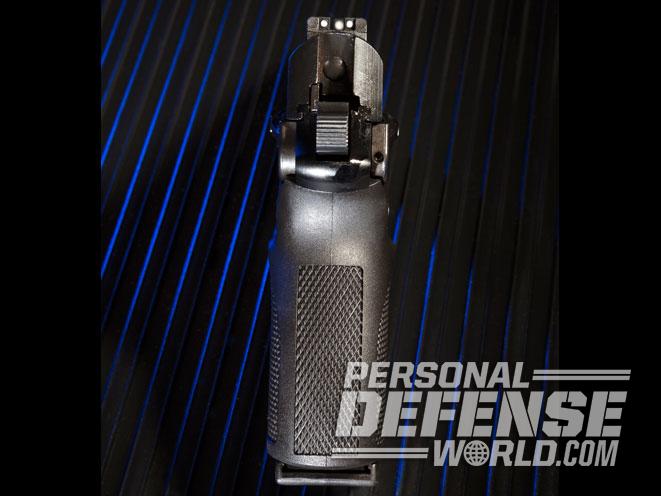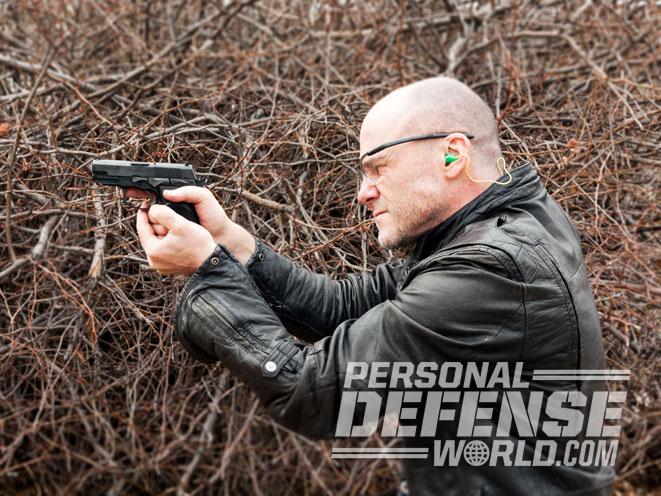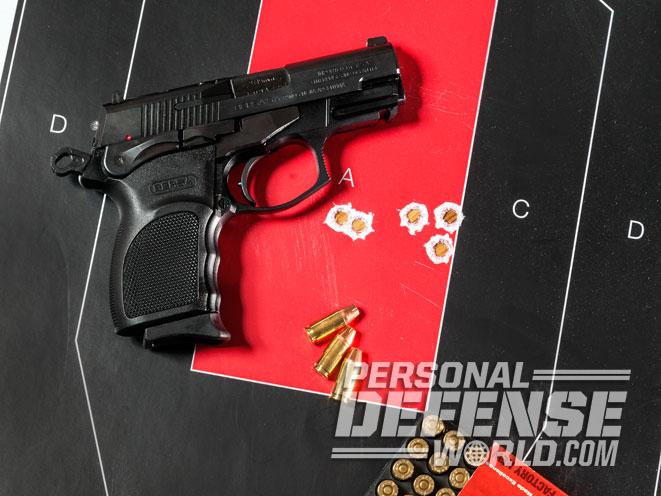There is an unimaginable number of compact 9mm pistols on the market. Quality varies with the price, and some simply feel better in the hand than others. That’s an important consideration.
I recently got my hands on a Bersa Thunder Pro Ultra Compact in 9mm. Bersa guns are manufactured in Argentina, so they may not be all that familiar to American shooters yet. Having said that, I was immediately impressed with the fit, feel and quality of this gun. Unlike some competing 9mm compacts, the Bersa offers a solid, hand-filling grip, thanks in part to its double-stacked 13-round magazine. That aids in control, making it easy to hold the gun on target. The gun comes supplied with two 13-round magazines. A mechanical loader is a big help when filling the magazine. The follower spring is pretty stout. I’d hate to try fully loading the magazine without some mechanical help.
Measuring 6.5 inches in length and tipping the scales at 23 ounces, this is not a petite firearm. It’s bulkier and heavier than many of the 9mm “pocket pistols” on the market. The full-sized Thunder Pro 9mm has a barrel that’s an inch longer and weighs in at 31 ounces. It also features a 17-round magazine. The Thunder Pro Ultra Compact is less concealable than some pistols but provides a reassuringly solid grip and a “big gun” feel. It fits very comfortably in my hand and aims very naturally. Forget carrying it in a pocket, this gun cries out for a holster.
Advertisement — Continue Reading Below
Covert Nine

Bersa’s Ultra Compact incorporates an improved Browning Petter barrel-locking system. This provides highly reliable feeding and dependable ejection. It’s unusual for any new pistol to run flawlessly right out of the box, but the Bersa managed this feat. The sample I tested digested four different factory loads without a single hiccup. Reliability is important on a pistol designed for self-defense, and my Bersa came through with flying colors.
RELATED STORY: Bersa’s BP380CC – Easy-To-Conceal and Great for Self-Defense
Advertisement — Continue Reading Below
A hand-filling, checkered polymer grip coupled with finger grooves up front made this gun very comfortable in my hand. It also points very naturally. The thumb-operated safety and extended slide release are ambidextrous and easy to reach. The magazine-release button is also ergonomically located, and you can reach it without altering your grip on the pistol. While this control is located on the left side, it can be easily switched to the opposite side for southpaw operation. The front of the triggerguard is squared off and grooved to provide solid seating for the off-hand’s index finger. This is a feature I appreciate—it aids a natural two-handed hold that helps stabilize your aim.

The frame is CNC machined from a tough, lightweight alloy, while the slide is blued steel. A Picatinny rail at the muzzle accommodates aftermarket laser sights and high-intensity lights, which could be particularly appreciated if you’re defending home and hearth. The 1911 I keep in my bedroom wears a Crimson Trace Lasergrip, which provides an easy-to-see aiming point even in a darkened room. An uninvited intruder seeing that ruby-red dot dancing on his chest may be a sufficient deterrent to end the matter without a shot being fired. If you’re forced to pull the trigger, I can’t think of a better
sight for low-light-level shooting.
Once you fire the first shot in double action (DA), the gun shifts to single-action (SA) mode. The manual safety is actually a decocking lever. The SA trigger comes back smoothly, with noticeable stacking just before the hammer falls. Some 10 pounds of pressure is required before the trigger breaks. That’s only an estimate because my RCBS trigger scale tops out at 8 pounds. I don’t mind a reasonably heavy trigger; it helps prevent accidental firing in the excitement of the moment. Once that first DA round leaves the barrel, the gun reverts to SA mode. The SA trigger on my test gun breaks crisply at an even 5 pounds, with only the barest hint of creep. The gun isn’t striker-fired. It features the reliable, time-honored hammer and firing pin system. I much prefer this arrangement over the “tinnier” internal striker.
Advertisement — Continue Reading Below
The Bersa’s open sights feature the familiar three-dot aiming system. Windage adjustments are possible by drifting the rear sight or the front blade sideways in their dovetails. No provision is made for altering elevation.
Easy Operation

Before I go any further, let’s talk price. The MSRP for this pistol is $500. I think that’s an eminently reasonable amount to pay for a gun of this quality. I’ve seen this model heavily discounted on some online sites, making it an even better bargain.
Advertisement — Continue Reading Below
Located on the right side of the slide, the gun’s external extractor throws empties clear with alacrity. A loaded-chamber indicator above and behind the ejection port can be checked visually or by feel to determine whether or not a round is chambered and ready to fire.
RELATED STORY: Gun Review – Bersa Thunder 40 Ultra Compact Pro
Magazines insert smoothly into the well, and eject sharply when the release button is pressed. If you ever need a combat reload, this is a real plus. The slide and frame fit snugly together—no shake or wobble is evident. The Thunder Pro Ultra Compact functioned smoothly from the first time I tried it, thanks in part to the full-length guide rails inside the frame that hold the slide securely for a tight lockup and consistent operation.
Advertisement — Continue Reading Below
Disassembly is simple and straightforward. Remove the magazine. Using your right thumb, rotate the disassembly latch 90 degrees. Now pull the slide/barrel assembly (which includes the recoil spring and guide) forward and off the frame. The recoil spring and guide then can be removed. Finally, remove the barrel from the slide. The guide rod has two full-length springs, one inside the other. This allows smooth, bind-free operation.
Reassemble in reverse order. There are no witness marks to line up, or anything that needs to be juggled in place. I wish all the pistols I own were this easy to field strip. Some are a real headache to service. To simplify matters, the Bersa owner’s manual illustrates each step in the assembly/disassembly process with a series of 10 photos. Bersa recommends cleaning and lightly lubricating the gun after each time it’s fired.
Range Time
Advertisement — Continue Reading Below

When I took the Bersa to the range, I fed it four different factory loads. While all functioned flawlessly (I’ve already noted how seldom this happens with a new gun fresh out the box), it seemed to like Black Hills’ 115-grain jacketed hollow point (JHP) +P load best. Fired off-hand at 15 yards, the pistol first grouped five rounds into 2.37 inches. That’s impressive. Subsequent targets produced groups ranging from 4.25 to 5 inches across, which is still not too shabby. The muzzle velocity averaged 1,195 fps.
Winchester’s 115-grain full metal jacket (FMJ) load put five consecutive bullets into a 7-inch circle. Black Hills’ ammo loaded with the 115-grain Barnes TAC-XP +P projectile churned up 1,105 fps and grouped into 7.37 inches.
RELATED STORY: Polymer Power – Bersa’s BP40CC .40 S&W Pistol
Advertisement — Continue Reading Below
Hornady’s 147-grain XTP load exited the gun at 1,079 fps and clustered into 8.25 inches. That was the largest grouping, but was still satisfactory performance for a self-defense firearm.
All told, I fired 300 rounds through the gun with no hangups of any kind. While 9mm recoil can be sharp, the Bersa proved easy to shoot throughout the exercise. I’d inadvertently left my padded shooting gloves at home, but I didn’t really need them. The gun got high marks for shooting comfort and controllability. Without my UpLula speedloader, I would have never been able to load and fire that many rounds in the course of an afternoon. The follower spring in magazine is pretty stiff.
To sum up, I call the 9mm Bersa Thunder Pro Ultra Compact one heck of a bargain. It’s one of the most reliable pistols I’ve tested right out of the box. It’s easy to shoot and delivers great accuracy. As another plus, it’s definitely priced right.
Advertisement — Continue Reading Below
For more information, call 732-493-0333 or visit http://bersa.eagleimportsinc.com.
